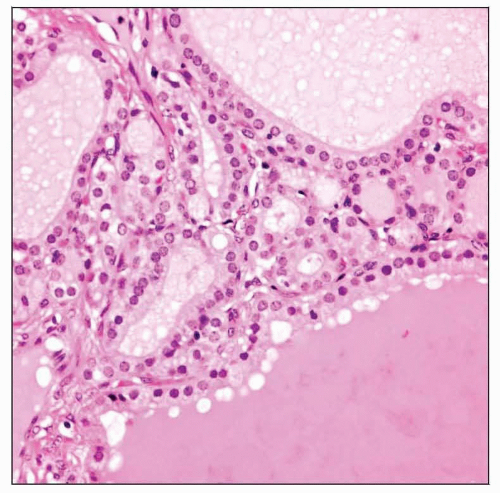Follicular Cell-Derived Lesions in Ectopic Locations (Struma Ovarii)
Bruce M. Wenig, MD
Key Facts
Terminology
Struma ovarii
Ovarian teratomas in which thyroid tissue is predominant (at least 50%) or sole tissue component
Strumal carcinoid
Ovarian tumor includes presence of thyroid tissue admixed with carcinoid tumor
Clinical Issues
5-15% of mature ovarian teratomas contain thyroid tissue
Presentation is similar to ovarian teratoma
Enlarging abdominal mass
Struma ovarii
Surgical removal is curative
Prognosis associated with malignant thyroid tumors in struma ovarii considered good, with overall survival rates of 89% at 10 years and 84% at 25 years
Strumal carcinoid
Prognosis considered excellent following surgical removal, even in presence of metastatic tumor
Microscopic Pathology
Struma ovarii
Normal-appearing thyroid follicular tissue (most common finding)
Rarely, thyroid neoplasms arise in struma ovarii
Thyroid papillary carcinoma most common
Strumal carcinoid
Characterized by presence of normal thyroid tissue admixed with carcinoid tumor
TERMINOLOGY
Definitions
Ovarian thyroid tissue
Presence of thyroid parenchyma in setting of ovarian teratoma
Thyroid tissue represents only minor component of ovarian teratoma
Struma ovarii
Ovarian teratomas in which thyroid tissue is predominant (at least 50%) or sole tissue component
Strumal carcinoid
Ovarian tumor includes presence of thyroid tissue admixed with carcinoid tumor
In this setting, other teratomatous elements usually absent
ETIOLOGY/PATHOGENESIS
Idiopathic
No known associated causes or risk factors
CLINICAL ISSUES
Epidemiology
Incidence
5-15% of mature ovarian teratomas contain thyroid tissue
Identification may be function of adequate sampling
Age
Struma ovarii
May occur over wide range, including 2nd-9th decades of life
Occurs mainly over 40 years of age
Strumal carcinoid
Majority are postmenopausal
Occur over wide age range, from 3rd-8th decades of life
Gender
Exclusively in women
Site
Exclusively limited to ovary
Bilaterality may occur in up to 5% of cases
Presentation
Struma ovarii
Presentation is similar to ovarian teratoma
Enlarging abdominal mass
Incidental finding on routine gynecologic (or urologic) evaluation
Other (uncommon) clinical presentations may include
Symptoms related to function of thyroid component (hyperthyroidism) occur in < 10%
Ascites that, in presence of ovarian mass, may be suspicious for ovarian carcinoma
Ascites and hydrothorax (“pseudo-Meig syndrome”) may occur
Strumal carcinoid
Presentation similar to ovarian teratoma
Abdominal mass
Acute abdominal pain
Incidental finding on routine gynecologic (or urologic) evaluation
Rarely, may initially be detected as ovarian mass complicating pregnancy
Other uncommon presentations may include
Constipation (peptide YY found in association with constipation)
Pain on defecation
Virilization, hirsutism
Symptoms related to hyperthyroidism rarely occur
Stay updated, free articles. Join our Telegram channel

Full access? Get Clinical Tree






